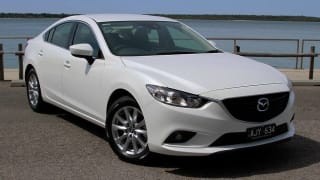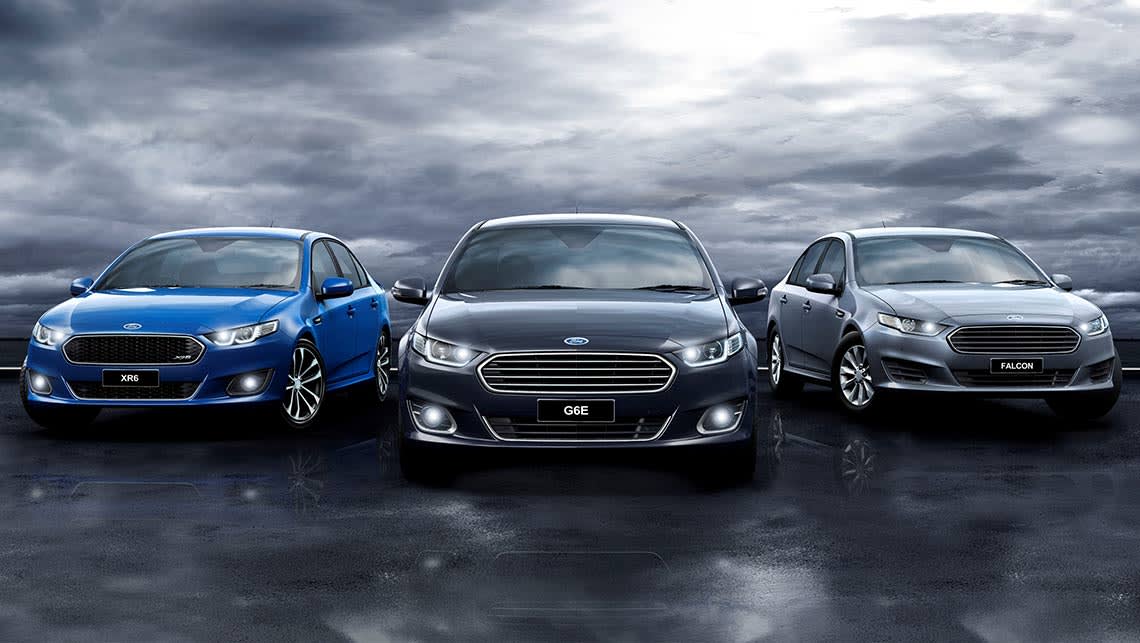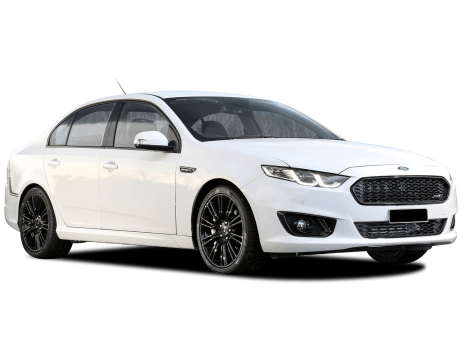
Mazda 6 Sport sedan 2016 review
Peter Anderson road tests and reviews the 2016 Mazda6 Sport sedan with specs, fuel consumption and verdict.
Browse over 9,000 car reviews

Australia may have been in the middle of a heat wave but as soon as the godfather of Ford Falcon started his address to the media for the last ever model, the heavens opened and the charcoal sky cracked with thunder and lightning.
Trevor Worthington, the softly spoken engineer who oversaw or had a hand in the Falcon for more than half its lifetime, forged ahead with the PowerPoint presentation as he attempted to cut through noise of the torrential rain pounding the roof.
It was another portent of doom for Australia’s oldest surviving automotive nameplate.

On the media test drive earlier in the day, a four-cylinder Falcon blew an engine hose and the air-conditioning conked out on another car. Then a tiger snake found its way into the hotel where media were staying.
You could be forgiven for thinking the Falcon was cursed. But in fact it’s just been damn unlucky.
The end is indeed nigh for the Falcon. Once this Falcon goes out of production in October 2016, there will be no more.
It’s difficult to gauge just how many people care about the Falcon because we’re certainly not buying it like we once did: Ford sold 10,000 Falcons last year -- it’s not even in the Top 20 sellers -- and October was the lowest monthly sales tally in 54 years (just 396 sales).
Yet the car that has carried three generations of Australians will always have a place in our hearts and the history books.
The FG X, as it will be known as among enthusiasts and the trade, will also be remembered as the car that started the domino affect of factory shutdowns and the end of Australia’s automotive manufacturing industry.
Holden and Toyota will also lock their factory gates in 2017, having been confronted with the same harsh reality that Australia’s manufacturing costs are too high, export opportunities too limited and our local car market too flooded with choice.
The Falcon may be a long way from its glory days as Australia’s top-selling car -- it last led the market 19 years ago, in 1995 -- but it didn’t deserve to die.
This model is without doubt the best yet, even if it lacks some basic mod-cons found on countless imports such as a sensor key, fuel-saving stop-start technology, radar cruise control or a blind spot warning system. Or such bare essentials as power windows that close with one touch.
Times have changed and the Falcon failed to move with it. Not even a powerful yet thrifty four-cylinder engine could save it.
Despite having exactly the same performance as the six-cylinder, just 1800 “Ecoboost” Falcons have been sold since Ford spent $230 million installing the modern and super-efficient engine. Less than half as many as it planned to build.
The Federal Government contributed $42 million towards the four-cylinder Falcon and other fuel-efficient models. But Federal Government departments bought just seven Ecoboost models.
Private buyers bought just 200 four-cylinder Falcons, confidential figures show, while fleets have taken delivery of 150.
The biggest buyers of the four-cylinder Falcon is Ford itself: issuing 600 company cars from April 2012 to October 2014.
No wonder it has posted a loss of $700 million in the past three years alone. Selling cars to yourself at a loss is not the path to success.
This proves, contrary to perception, fuel economy is not the reason Australians have fallen out of love with big Aussie cars.
They fell out of love with sedans and instead embraced small cars, SUVs and utes that better suit their needs.
Speak to the executives at Ford, and you’ll find only a handful of them drive Falcons (the boss Bob Graziano wisely drives a four-cylinder model while the head of marketing, David Katich, drives an XR6, the model favoured by rental fleets and private buyers and which accounts for half of all Falcon sales these days).
Their wives and loved ones drive an SUV or a small imported car -- just like the rest of the country.
What’s the new Falcon FG X range like to drive? To be blunt: exactly the same as the Falcon that’s been on sale for six years.
The FG X Falcon may look all new but it’s a style over substance makeover.
The doors, roof, glass and rear fenders are the same as before; only the bonnet, front fenders, boot, lights and bumpers are new.
The engines and transmissions are carry-over, except for the six-speed automatic which now comes from China.
The XR8 is a revelation to drive and performance fans have rightly started to form an orderly cue
It’s the facelift the Falcon had to have. Ford couldn’t afford to do anything more.
At least it spent the money in the right places and made it look world class. It even stumped up for three different sets of headlights: base model, luxury model, and XR models (the latter two with tiny logos inside the lamp).
Why did Ford not do more to make the Falcon drive differently, or equip it with more technology? Put simply: as sales nosedived over the past decade, Ford had less money to reinvest in the new model.
This Falcon was locked away before the factory shutdown was announced. Which explains why Ford made so many visual changes. Had it known the end was near it may have elected to soldier on with the old model.
So this is the $103.5 million Falcon, brought to you with $34 million from taxpayers.
The fresh new face brings the Falcon bang up to date with Ford’s global styling direction, and is designed to warm us to the look of the car that will eventually replace it: the next-generation Ford Mondeo, a four-cylinder front-drive car that competes with the Toyota Camry.
The engines, suspension and mechanical parts are all the same as before, but the XR8 has been revived by using the best bits -- including the supercharged V8 engine -- from the previous Falcon GT.
Inside is the same as before except for a new 8-inch touch-screen with a digital radio, rear view camera and a clever emergency system that will dial 000 if you have a crash in which an airbag is deployed. This makes the FG X Falcon the first locally-made car to have this potentially life-saving feature.
The instrument display also gets a refresh with a newly designed speedometer and tachometer.
All models also come from front parking sensors as well as those on the rear -- if you can’t build a smaller car at least make it easier to park -- and the sports models now get black roof lining rather than grey.
Best of all, though, the prices have come down. The headline says the savings are up to $9600, depending on the model. But the reality is that no-one paid the full RRP for a Falcon for decades and the new prices reflect what customers were actually paying.
The range now starts at $35,990 for an XR6 and tops out at $54,690 for the reborn XR8.
The Falcon is as roomy and comfortable as it ever was, and soaks up bumps and thumps with ease. It’s most at home on the open road, where the soft suspension and direct steering make life easy.
The XR8 is a revelation to drive and performance fans have rightly started to form an orderly cue. It feels as nimble as a Fiesta ST even though it’s an 1800kg sedan, although the suspension may be a tad too firm for some (enthusiasts will embrace it).
The steering is superbly weighted, the Brembo front brakes have plenty of bite (the rears have cross-drilled and vented discs but use a standard single-piston floating caliper) and the performance and sound of the supercharged V8 are quite simply breathtaking.
Meanwhile, at the other end of the scale, the new energy-saving Michelin tyres on the most basic model are an improvement on those used previously -- they’re quieter and have more grip -- and the power from the LPG, four-cylinder and six-cylinder versions is effortless.
Downsides? The XR6 Turbo, with arguably the best engine ever designed, developed and produced in Australia, is a massive let down. Ford has left it untouched and, while comfortable, the suspension feels way too floaty over bumps and in bends. Just ask any highway patrol officer who has a Falcon XR6 Turbo as a company car.
Why Ford did not make Brembo brakes an option on the XR6 Turbo is baffling. The brakes from the FPV F6 had already been calibrated for the XR6 Turbo (for exclusive use by NSW Highway Patrol and other police departments that ask for it).
All Ford had to do was give customers the option. It’s even more galling when you consider the XR6 Turbo has as much straight-line speed as the XR8. This explains why the standard brakes on the XR6 Turbo are, quite frankly, not up to the job on a car with this much performance.
So the XR8 gets proper stopping power but XR6 Turbo customers don’t deserve the same option? It’s a bitter disappointment and, sadly, a stark reminder of how out of touch Ford can be with performance-car buyers.
Elsewhere the same familiar bugbears remain across all FG X Falcon models: the seating position is too high, and the steering wheel is too low and doesn’t reach close enough to the driver.
Are these enough to stop someone from buying a new Falcon? Probably not. But cautiously Ford is not counting on a sales resurgence.
It says it expects to have enough orders to keep the factory running until October 2016. For better or worse, it says “customers will decide”.
| Vehicle | Specs | Price* | |
|---|---|---|---|
| (base) | 4.0L, ULP, 6 SP AUTO | $17,600 – 22,220 | 2015 Ford Falcon 2015 (base) Pricing and Specs |
| (LPI) | 4.0L, LPG, 6 SP AUTO | $19,030 – 24,090 | 2015 Ford Falcon 2015 (LPI) Pricing and Specs |
| Ecoboost | 2.0L, ULP, 6 SP AUTO | $12,980 – 17,380 | 2015 Ford Falcon 2015 Ecoboost Pricing and Specs |
| (LPI) | 4.0L, LPG, 6 SP AUTO | $14,080 – 18,590 | 2015 Ford Falcon 2015 (LPI) Pricing and Specs |
$11,990
Lowest price, based on 91 car listings in the last 6 months